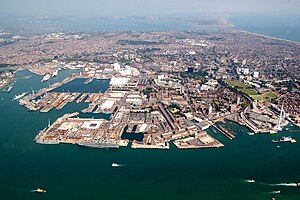
Royal Navy Dockyards (more usually termed Royal Dockyards) were state-owned harbour facilities where ships of the Royal Navy were built, based, repaired and refitted. Until the mid-19th century the Royal Dockyards were the largest industrial complexes in Britain.[1]
From the reign of Henry VII up until the 1990s, the Royal Navy had a policy of establishing and maintaining its own dockyard facilities (although at the same time, as continues to be the case, it made extensive use of private shipyards, both at home and abroad). Portsmouth was the first Royal Dockyard, dating from the late 15th century; it was followed by Deptford, Woolwich, Chatham and others. By the 18th century, Britain had a string of these state-owned naval dockyards, located not just around the country but across the world; each was sited close to a safe harbour or anchorage used by the fleet. Royal Naval Dockyards were the core naval and military facilities of the four Imperial fortresses - colonies which enabled control of the Atlantic Ocean and its connected seas. The Royal Dockyards had a dual function: ship building and ship maintenance (most yards provided for both but some specialised in one or the other). Over time, they accrued additional on-site facilities for the support, training and accommodation of naval personnel.
For centuries, in this way, the name and concept of a Royal Dockyard was largely synonymous with that of a naval base. In the early 1970s, following the appointment of civilian Dockyard General Managers with cross-departmental authority, and a separation of powers between them and the Dockyard Superintendent (commanding officer), the term 'Naval Base' began to gain currency as an official designation for the latter's domain.[citation needed] 'Royal Dockyard' remained an official designation of the associated shipbuilding/maintenance facilities until 1997, when the last remaining Royal Dockyards (Devonport and Rosyth) were fully privatised.
- ^ Hawkins, Duncan (Spring 2015). "Deptford's Royal Dockyard: archaeological investigations at Convoy's Wharf, Deptford, 2000–2012" (PDF). London Archaeologist. 14 (4): 87–97. Retrieved 6 June 2021.